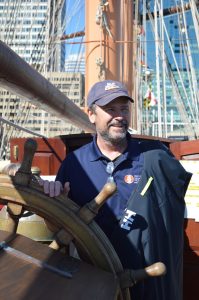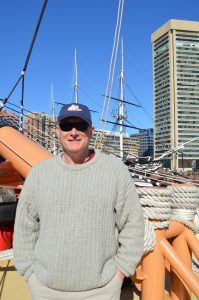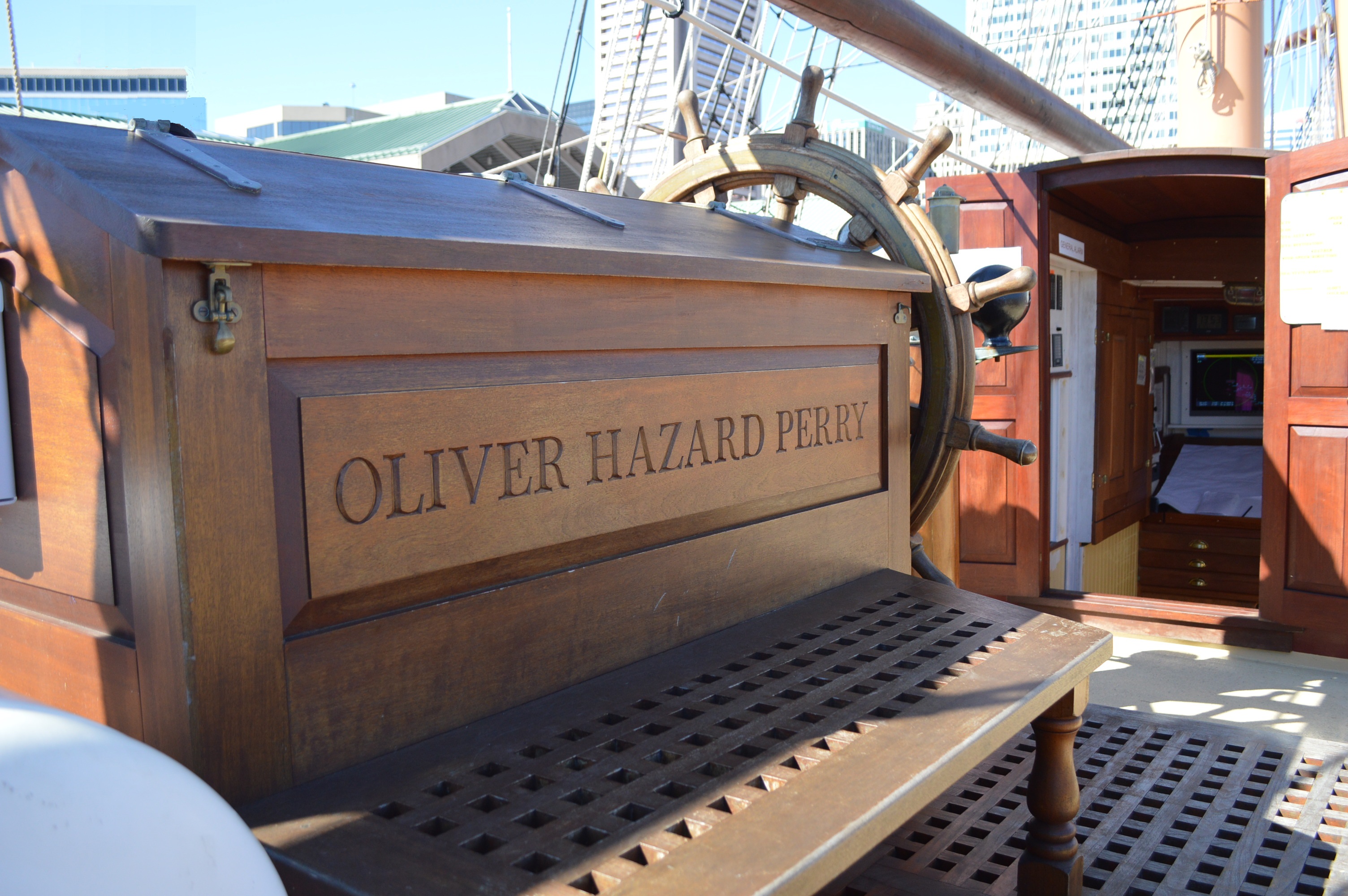Oliver Hazard Perry: Tall ship shapes students for careers at sea
In an era of colossal cruise-liners and nuclear-powered submarines, the notion of sending sailors aloft to secure canvas sails might seem best left to a Johnny Depp movie. But for maritime students who sign on for a hitch aboard the Tall Ship SSV Oliver Hazard Perry, climbing rope ladders is an intriguing step to an exciting career at sea.
The first ocean-going full-rigged ship to be built in the U.S. in over 100 years, the Oliver Hazard Perry is America’s largest civilian sailing school vessel. Named for the nineteenth-century American naval hero whose battle flag read, “Don’t Give Up the Ship”, the Rhode Island-based Perry was launched in 2013.
By the numbers, she is 200 feet in length with a beam of 38 feet. Three towering masts hold seven miles of rigging, twenty sails, and 14,000 square feet of canvas. 160 belaying pins help to hold the rigging in place. In total, the Perry is 13 ½ stories tall.

U.S. Coast Guard safety standards for sailing school vessels differ from those of passenger vessels on a comparable route, because persons aboard training ships are not passengers, but rather participants who fully share in the ship’s operation.
With a seventeen-member professional crew and accommodations for 32 people overnight, the Perry is the perfect size for intimate instruction in the rigors of life at sea. But learning the difference between knots and nauts is only part of the curriculum. Underscoring the indispensable importance of being a good shipmate is the goal for all hands on board.
Last month, while on a two-week journey to Florida, the Perry made a brief stop in Baltimore as part of Sail Baltimore. Greeting this reporter for a tour of the ship was Captain Anthony Arrow.
“There are a lot of misconceptions,” said Arrow. “People hear we are sailing the Caribbean and they think it’s easy, but this boat operates 24-hours 7-days a week. We always have crew working. The amount of work it takes to maintain a vessel such as this is enormous. The crew has to be diligent. They require a lot of training, and not just the sailing part but also about navigation, safety, fire-fighting, and what to do if we had a collision.”
Arrow said he has been working at sea in one way or another for 35 years. For most of that time, he has been in the education field.
“I’d never been on a boat ‘til I was about 20 years old, when my dad signed us up on the Mystic Clipper, which sailed out of Annapolis. We went on for a week and got yelled at and did dishes and sailed the boat. I really liked it, so I bugged the captain for a job, and he hired me the next season as a steward.
“I spent a few years on passenger boats, but I saw that the education boats were doing cooler trips; going to the Carribean and Europe. I also saw what an incredible way it was to teach people. It’s all hands-on instruction, and that works for me. I was not a successful classroom-type student, so seeing it work for young people is the reason I became so passionate about it.

“Initially, most of our students came from Rhode Island, but we have open enrollment programs that anyone can come to. We just did a program with the Mid-Atlantic Maritime Academy. The students – mostly young adults – had just finished something called a Maritime Boot Camp. A lot of them come from a background where getting a job is not easy, so this program gives them the skills to get entry level positions in the maritime field. Once they finish the schooling part, we take them aboard where they get 160 hours of practical experience, so they know what to expect in a career at sea.”
What kinds of jobs are available to Perry veterans?
“Two of them are going into the stewards program, which means cooking,” said Arrow. “They already have jobs with one of the large cruise lines. One young woman is headed into shipbuilding, while the other two guys want to go into engineering. They don’t have jobs lined up yet, but the school is pretty good at placing them. They could end up on a tugboat, or maybe a work boat out in the Gulf of Mexico. The credentials the young people earn are essential credentials. It gives them a huge leg up on getting into entry level positions. Plus, they can build their credentials over the next 3-5 years, to get a pretty stable career.”
Arrow told me the shipboard instruction is open not only to young people but also to adults.
“We can help open a door to a lifestyle they had only imagined and give them a different way to view the world. We’re an unrestricted oceans vessel, which means we can go anywhere in the world.”
Looking at life decidedly differently, after years behind a desk, is Virginia native, Sid L. Dunn.

“I was in the insurance business for the last 16 years,” explained Dunn. “I reached an age where I wanted to retire and become a merchant marine. I went to the Mid-Atlantic Maritime Academy, so sailing on this vessel along with my classmates is our internship. I’m really enjoying it.
“I’ve been on this ship now for two weeks and I can tell you, the crew really knows what they are doing. Five of my classmates left yesterday. Two of them have already landed positions with cruise lines and are headed to Hawaii. Another is going to work in a shipyard.”
Dunn said he was originally scheduled to sail as far as Jacksonville, FL, but he was asked to stay aboard until the Perry reached Galveston. Dunn acknowledged the fact that jobs on square-rigged ships are few and far between, but he said ultimately, it is all about the ship-board experience.
“Learning how to be a good shipmate while living in close quarters with the others onboard; that’s paramount. But it’s also about learning basic seamanship skills. They’ve been doing this for hundreds of years, and the basics have never changed.
“My goal is to get a position with NOAA (National Oceanic and Atmospheric Administration.) They have seventeen ships worldwide, and I like their mission of research – seeing what we can do for the environment. I live in Virginia Beach, and there is a NOAA station in Norfolk. That would be best for me, but I’d go wherever they want me to go.”
Before wrapping up my tour, Arrow introduced me to several other members of the crew. Two were Katie Riley – a marine biology instructor who holds an officer-level grade aboard the Perry, and Donna Vestuti – a top-flight chef from New York, who signed on for a taste of adventure.
Could a scientist, a chef and an insurance professional have more to offer a seasoned journalist?
Arrow said, “If you really want to know what it’s like, why don’t you come aboard for a voyage?”
So I will.
Starting Wednesday, this writer will be sailing from New Orleans to Annapolis on the SSV Oliver Hazard Perry. Don’t look for updates to this piece, arm-length selfies, or a meandering blog – I’ll be leaving my laptop at home. When I return, however, I hope to share my shipboard experiences in a series of special reports.
Till then, this much I can promise: I won’t give up the ship.


Anthony C. Hayes is an actor, author, raconteur, rapscallion and bon vivant. A one-time newsboy for the Evening Sun and professional presence at the Washington Herald, Tony’s poetry, photography, humor, and prose have also been featured in Smile, Hon, You’re in Baltimore!, Destination Maryland, Magic Octopus Magazine, Los Angeles Post-Examiner, Voice of Baltimore, SmartCEO, Alvarez Fiction, and Tales of Blood and Roses. If you notice that his work has been purloined, please let him know. As the Good Book says, “Thou shalt not steal.”

